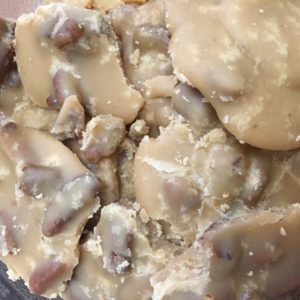
Praline’s also known as the “pecan candy” was originated in the seventeenth-century in France by chef of César, duc de Choiseul, Comte du Plessis-Praslin when he coated almonds with sugar. French settlers brought the tradition of praline’s along with them to Louisiana. When African-Americans began working in French migrants’ kitchens, they replaced the almonds to pecans and added milk. Throughout the 1800s, African-American women began selling praline’s in New Orleans, and those women became the most popular street vendors. During the 1900s, the tourism industry grew and French Quarters started opening up praline stores with life size “praline mammies” in front of the store.
As a child my grandmother on my father’s side used to always give them to me. I used to get them at parties or sometimes after dinner. My mother’s father used to take me to his favorite restaurant called, Margarita’s Mexican Café, on Crenshaw Boulevard and 50th Street. Growing up I thought of these as cookies, I just learned that it is a candy. Usually I would just eat one or two because they were so sweet. I’ve never seen praline’s been made before but it seemed pretty easy. As I was trying to follow certain instructions on how they are made, I quickly saw that the first batch wasn’t going to turn out to well. I sat and thought to myself, oh no, I’m the mom from the book by Ruth Reichl, I have completely destroyed these poor cookies. Feeling defeated but willing to try again, I did it. I learned that whatever you do, don’t stop stirring the mix. All I remember about my grandmother is that she was always in the kitchen, weather she was cooking, drinking coffee or watching mass, she was in the kitchen. Most, if not all of our talks were in the kitchen; she would have pralines set out on the table all the time and I would sit and break apart the “cookie” half way listening to mass and half listening to her. my mother’s father and my father’s mother were my two favorite grandparents and I no longer have either of them here with me. But this assignment has made me see that they are here with me all the time.
I decided to do my nutritional analysis on pecans since that was one of the ingredients that changed when it was brought into Louisiana due to the extensive amount of pecan trees. Pecans are a species of hickory that have a native to Mexico in the late 1600s and early 1700s. the first planting of a pecan tree was in Long Island, New York. The tree grows from 66-131 feet high, spreads 39-75 feet, with a 6.6-foot trunk. Since the pecan is considered a fruit, the seed part is edible and has a buttery flavor. The pecan seed is also used in wood making and flavoring of food. According to Shape, the National Pecan Shellers Association states that pecans are a healthy unsaturated fat and can help lower bad cholesterol. They contain over 19 vitamins and minerals and rich in age defying antioxidants.
In addition, today there are many forms and ways to make pralines. Many cover them in chocolate, pour it on top of brownies, add coconut, and even add ice cream.
Traditional Praline Instructions
Ingredients:
1 stick of unsalted butter
½ cup of light brown sugar
1 ½ cup of white sugar
1 ½ cup of pecans
½ cup of evaporated milk
A teaspoon of exact (vanilla or cameral)
Tools:
Wooden spoon
Nice size pot
Wax paper
Directions:
Before you start, make sure you have all your ingredients already measured out and have the space to set the candy down ready.
Put the wax paper on top of newspaper so you don’t mess up your counter top.
Put the pot on high heat and add all ingredients in the pot (excluding pecans and exact).
Always stir.
Allow the ingredients to come to a boil.
There are two boils that happen. First a rapid boil and then a medium volcano boil. You want the one the slow volcano boil.
Once you reach that, put the fire on low and let it stand for three minutes only.
Once that is done, take it off the fire, add in the pecans, and stir for about one minute.
Never stop stirring.
Add the exact and keep stirring until it comes to a creamy texture.
Put the candy onto the wax paper and let cool.
References
Borsari, K. “Pop a Pecan, Not a Pill,” Shape. Retrieved November 7, 2016 from, http://www.shape.com/blogs/fit-foodies/pop-pecan-not-pill
n.d. “The History of Pralines,” Southern Candymakers. Retrieved November 7, 2016 from, https://www.southerncandymakers.com/history-of-pralines
Nunez, M. C. “Praline or “Pecan Candy” Vendors,” New Orleans Historical. Retrieved November 7, 2016 from, http://www.neworleanshistorical.org/items/show/259
Pecans. (n.d.). In Wikipedia. Retrieved November 8, 2016, from https://en.wikipedia.org/wiki/Pecan
